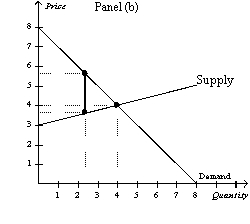Figure 8-14


-Refer to Figure 8-14.Panel (a) and Panel (b) each illustrate a $2 tax placed on a market.In comparison to Panel (a) ,Panel (b) illustrates which of the following statements?
Definitions:
Market Segments
Subsets of a market made up of people or organizations with one or more characteristics that cause them to demand similar product and/or services based on qualities of those products such as prices or function.
Product Prices
The amount of money required to purchase a good or service, often influenced by factors such as production costs, competition, and demand.
Narrow Range
A situation where variations or differences within data points, options, or outcomes are minimal or significantly limited.
Blue Ocean Strategy
A business strategy that focuses on creating new market spaces (blue oceans) where there is no competition, as opposed to competing in existing industries (red oceans).
Q127: Total surplus is represented by the area
Q128: Which of the following is a tax
Q183: Connie can clean windows in large office
Q189: Refer to Figure 8-9.The producer surplus without
Q291: Without free trade,the domestic price of a
Q318: When a country that imports a particular
Q322: Refer to Figure 8-8.The deadweight loss of
Q339: Refer to Figure 9-2.The world price for
Q370: When markets fail,public policy can<br>A) do nothing
Q406: Refer to Figure 9-15.As a result of